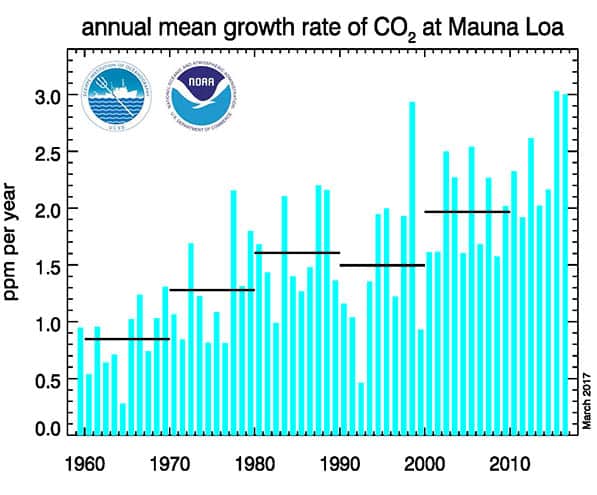CO2 growth rate sets new record in 2015-16. Increase in the past ten years is 100 to 200 times as fast as the increase that ended the last ice age
In 1992, at the Rio Earth Summit, the great powers promised to slash greenhouse gas emissions. 25 years later, things are worse than ever.

Graph shows the annual mean carbon dioxide growth rates observed at NOAA’s Mauna Loa Baseline Atmospheric Observatory.
CARBON DIOXIDE LEVELS ROSE AT
RECORD PACE FOR 2ND STRAIGHT YEAR
U.S. National Oceanic and Atmospheric Administration
March 10, 2017
Carbon dioxide levels measured at NOAA’s Mauna Loa Baseline Atmospheric Observatory rose by 3 parts per million to 405.1 parts per million (ppm) in 2016, an increase that matched the record jump observed in 2015.
The two-year, 6-ppm surge in the greenhouse gas between 2015 and 2017 is unprecedented in the observatory’s 59-year record. And, it was a record fifth consecutive year that carbon dioxide (CO2) rose by 2 ppm or greater, said Pieter Tans, lead scientist of NOAA’s Global Greenhouse Gas Reference Network.
“The rate of CO2 growth over the last decade is 100 to 200 times faster than what the Earth experienced during the transition from the last Ice Age,” Tans said. “This is a real shock to the atmosphere.”
Globally averaged CO2 levels passed 400 ppm in 2015 — a 43-percent increase over pre-industrial levels. In February 2017, CO2levels at Mauna Loa had already climbed to 406.42 ppm.
Measurements are independently validated
NOAA has measured CO2 on site at the Mauna Loa observatory since 1974. To ensure accuracy, air samples from the mountaintop research site in Hawaii are shipped to NOAA’s Earth System Research Laboratory in Boulder, Colorado, for verification. The Scripps Institution of Oceanography, which first began sampling CO2 at Mauna Loa in 1956, also takes independent measurements onsite.
Emissions from fossil-fuel consumption have remained at historically high levels since 2011 and are the primary reason atmospheric CO2 levels are increasing at a dramatic rate, Tans said. This high growth rate of CO2 is also being observed at some 40 other sites in NOAA’s Global Greenhouse Gas Reference Network.


